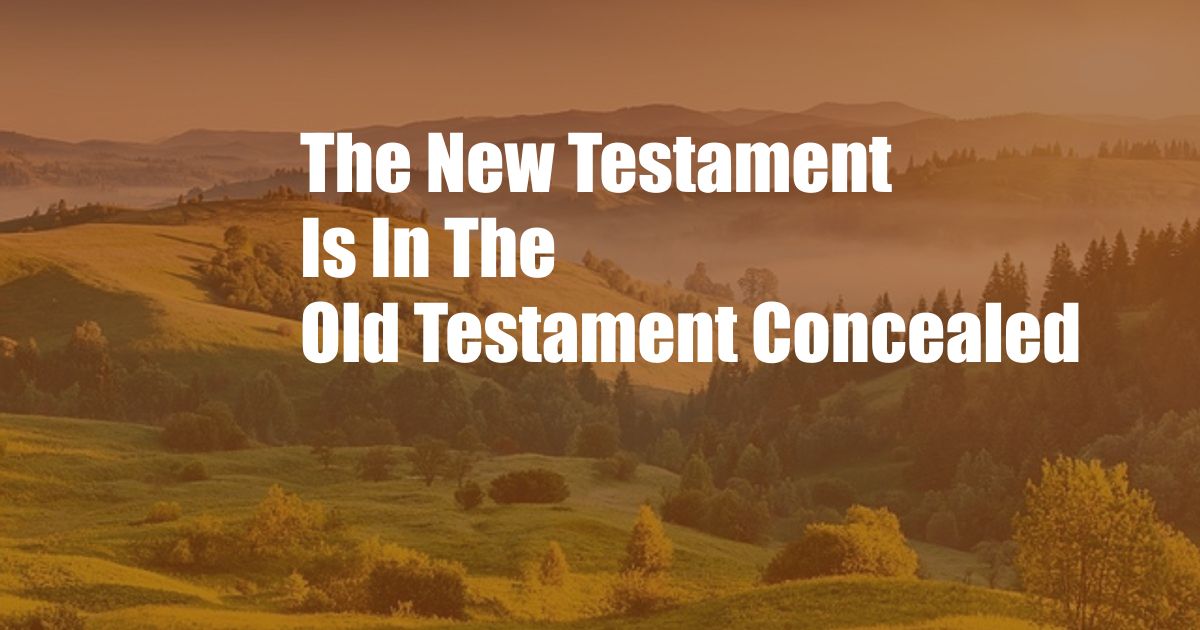
The New Testament Is in the Old Testament Concealed
In the tapestry of human history, religion has played a pivotal role in shaping our beliefs, values, and societal structures. Among the most influential religious texts is the Bible, a collection of ancient writings that holds profound significance for billions of people worldwide. One intriguing aspect of the Bible is the relationship between the Old Testament and the New Testament.
For centuries, scholars and theologians have pondered the hidden connections between these two testaments. Some believe that the seeds of the New Testament were already present in the Old Testament, concealed within its narratives, prophecies, and rituals. This belief, known as typology, suggests that many events, characters, and symbols in the Old Testament foreshadow or prefigure those in the New Testament.
Typology and the Old Testament
Typology is a hermeneutical approach that seeks to uncover the deeper meaning and significance of biblical texts by identifying correspondences between events, individuals, or objects in the Old and New Testaments. According to typological interpretation, God’s plan of redemption is laid out throughout the entire Bible, with the Old Testament serving as a foreshadowing of the New Testament’s fulfillment.
For example, the sacrificial system in the Old Testament is often seen as a type of Christ’s sacrifice on the cross. The Passover lamb, which was slain to deliver the Israelites from slavery in Egypt, is considered a prefiguration of Jesus, who died to redeem humanity from sin. Likewise, the tabernacle in the wilderness is believed to be a type of heaven, where God dwells with His people.
The New Testament in the Old Testament
Beyond specific typological correspondences, some theologians argue that the entire narrative of the Old Testament points forward to the New Testament. The creation account, the story of the patriarchs, the Exodus, and the establishment of Israel are all seen as preparations for the coming of Christ and the establishment of the New Covenant.
For instance, the Israelites’ wilderness wanderings can be interpreted as a type of Christ’s temptation in the wilderness. The Israelites’ rebellion and idolatry foreshadow the rejection of Christ by His own people. The conquest of the Promised Land prefigures Christ’s triumph over sin and death.
Latest Trends and Developments
In recent years, there has been a resurgence of interest in typology among biblical scholars. This renewed interest is driven by a desire to understand the unity and coherence of the Bible and to appreciate the richness and depth of its message. However, it is important to note that not all theologians embrace typological interpretation to the same extent.
Some scholars argue that excessive typologizing can lead to a superficial reading of the biblical text, ignoring its historical and literary context. Others caution against using typology as a proof-texting method to support preconceived theological positions.
Tips and Expert Advice
For those who are interested in exploring the topic of typology further, here are some tips and expert advice:
Read the Bible carefully and prayerfully, paying attention to both the Old and New Testaments as a unified whole. Be open to the possibility that there may be deeper connections and meanings within the text.
Study the history and context of the biblical texts to understand their original meaning and purpose. This will help you to avoid imposing your own interpretations onto the text.
FAQ
- What is typology?
Typology is a method of biblical interpretation that seeks to uncover connections and correspondences between events, individuals, or objects in the Old and New Testaments. - How can typology help us understand the Bible?
Typology can help us to see the unity and coherence of the Bible and to appreciate the richness and depth of its message. It can also help us to understand how God’s plan of redemption unfolds throughout history. - Is typology a reliable method of interpretation?
Typology is a valuable hermeneutical approach, but it should be used with caution. It is important to consider the historical context of the text and to avoid imposing your own interpretations onto it.
Conclusion
The relationship between the Old Testament and the New Testament is a complex and multifaceted one. The concept of typology suggests that the seeds of the New Testament were already present in the Old Testament, concealed within its narratives, prophecies, and rituals. While some theologians embrace this view, others caution against using typology excessively.
Ultimately, the question of whether the New Testament is in the Old Testament concealed is a matter of interpretation. However, by approaching the Bible with a spirit of humility and openness, we can gain a deeper understanding of its message and its relevance for our lives today.